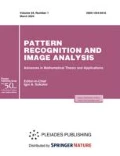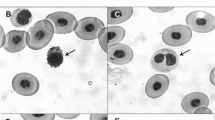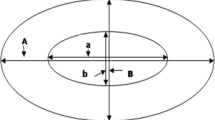Abstract
Fish erythrocytes released from erythropoietic sites are immature. During circulation, they increase their own surface, while the cell body and nuclei begin to become more elliptical and less spherical during maturation. The relative abundance of different developmental stages represents an erythron profile which could be a more sensitive indicator of contamination than classic hematological indices. In this study, we analyzed blood smears of the common nase (Chondrostoma nasus) and vimba bream (Vimba vimba) with the main goal to identify the determinants of the developmental stage of erythrocytes. Based on parameters developmental stages, erythrocytes are categorized into immature, intermediate or mature. In this investigation we have used four classification methods: the Two Step Cluster analysis, the K-Means Cluster analysis, and Neural Networks–Multilayer Perceptron and an Ordinal Regression model. Our findings clearly justify that Multilayers Perceptron and OLR models are appropriate to classify the developmental stage of fish erythrocytes in both species.






Similar content being viewed by others
COMPLIANCE WITH ETHICAL STANDARDS
Conflict of interests. The authors declare that they have no conflict of interest. Statement on the welfare of animals. All applicable international, national, and/or institutional guidelines for the care and use of animals were followed.
REFERENCES
S. Nazlibilek, D. Karacor, T. Ercan, M. H. Sazli, O. Kalender, and Y. Ege, “Automatic segmentation, counting, size determination, and classification of white blood cells,” Meas. 55, 58–65 (2014).
S. Nowaczewski and H. Kontecka, “Haematological indices, size of erythrocytes and hemoglobin saturation in broiler chickens kept in commercial conditions,” Anim. Sci. Pap. Rep. 30 (2), 181–190 (2012).
A. H. Houston, “Review: Are the classical hematological variables acceptable indicators of fish health?” Trans. Am. Fish. Soc. 126 (6), 879–894 (1997).
A. H. Houston and A. Murad, “Hematological characterization of goldfish, Carassius auratus L., by image analysis: effect of thermal acclimation and heat shock,” Can. J. Zool. 69 (8), 2041–2047 (1991).
M. W. Rowan, “Use of blood parameters as biomarkers in brown bullheads (Ameiurus nebulosus) from Lake Erie tributaries and Cape Cod ponds,” Doctoral Dissertation (The Ohio State University, Columbus, 2007).
X. Liu, “Ordinal regression analysis: Fitting the proportional odds model using Stata, SAS, and SPSS,” J. Mod. Appl. Stat. Methods. 8 (2), Article 30, 632–645 (2009).
I. N. Martínez, J. M. Morán, and F. J. Peña, “A two-step cluster procedure after principal component analysis identifies sperm subpopulations in canine ejaculates and its relation to cryoresistance,” J. Androl. 27 (4), 596–603 (2006).
J. H. Kong, D. R. Fish, R. L. Rockhill, and R. H. Masland, “Diversity of ganglion cells in the mouse retina: unsupervised morphological classification and its limits,” J. Comp. Neurol. 489 (3), 293–310 (2005).
V. Aliko, M Qirjo, E. Sula, V. Morina, and C. Faggio, “Antioxidant defense system, immune response, and erythron profile modulation in gold fish, Carassius auratus, after acute manganese treatment,” Fish Shellfish Immunol. 76, 101–109 (2018).
Funding
This work was supported by the Ministry of Education, Science and Technological Development of Serbia, grant no. OI173045.
Author information
Authors and Affiliations
Corresponding authors
Additional information

Dr. Sladjana Spasić received her MSc degree in artificial intelligence in 2003 and her PhD degree in applied mathematics in 2007 with a thesis on fractal analysis of biological material, both at the Belgrade University, Serbia. From 2003–2008 she was an assistant research professor/assistant professor at the Institute for Multidisciplinary Research, University of Belgrade (IMSI), Belgrade, Serbia, and Singidunum University (SU) at the Department of Informatics and Computer Science, respectively. From 2008 to 2013, she was an associate professor at IMSI and SU and since 2018 she has been working as a full professor at the same institutions. She has more than 20 years of working experience as a researcher and more than 40 published papers in International Citation Index journals; she edited one book and published one textbook in statistics. Her interest includes all multi-scale structural aspects of signals and images and their applications to practical biological problems as well as the application of mathematical and statistical analysis in ecology and physiology.

Dr. Srdjan Subotić received his MSc degree in biology in 2010 and the PhD degree in ecology 2015 with a thesis on element bioaccumulation and bio-magnification in fish tissues, both obtained at the University of Belgrade, Serbia. From 2014 to 2017 he worked as a teaching assistant at the Faculty of Biology, University of Belgrade. From 2017 he is employed as a research fellow at the same institution. His interests are various aspects of fish ecology, such as ecotoxicology, diet and habitat, hematology, and population ecology.

Dr. Željka Višnjić-Jeftić received her BSc in 2002 and the PhD degree in 2012 in ecology and environmental protection with a thesis: “Ecological and toxicological study of the Pontic shad (Alosa immaculate Bennett, 1835) in the Danube River in Serbia” both obtained at the University of Belgrade, Serbia, Faculty of Biology. 2005–2008 Research Trainee, Centre for Multidisciplinary Studies, University of Belgrade; 2008–2013 research assistant, Institute for Multidisciplinary Research, University of Belgrade; 2013–2018 research fellow, Institute for Multidisciplinary Research, University of Belgrade; 2018-present senior research fellow, Institute for Multidisciplinary Research, University of Belgrade. Research field: ecology, ecotoxicology, environmental protection, ichthyology, hydrobiology.

Dr. Mirjana Lenhardt is a research professor at the Institute for Multidisciplinary Research and Institute for Biological Research University of Belgrade, Serbia. She has more than 30 years’ experience working as a researcher in the field of ichthyology, fish ecology, eco-toxicology, and fish biochemistry. The part of her work was devoted to endangering factors of migratory fish species and their protection as well as to the investigation of non-native fish species. Dr. Mirjana Lenhardt has published more than 70 papers in International Citation Index journals and 7 chapters in books. She is an Expert Group Leader for the Fishery/Fish Biology of International Association for Danube Research.
Rights and permissions
About this article
Cite this article
Spasić, S., Subotić, S., Višnjić-Jeftić, Ž. et al. Application of Different Classification Methods to Determine the Developmental Stage of Fish Erythrocytes of the Common Nase (Chondrostoma nasus) and Vimba Bream (Vimba vimba). Pattern Recognit. Image Anal. 30, 43–51 (2020). https://doi.org/10.1134/S1054661820010150
Received:
Revised:
Accepted:
Published:
Issue Date:
DOI: https://doi.org/10.1134/S1054661820010150




